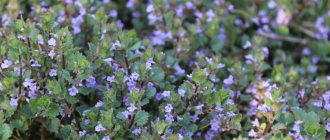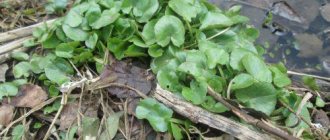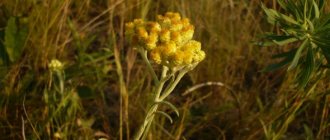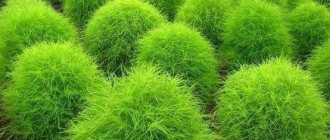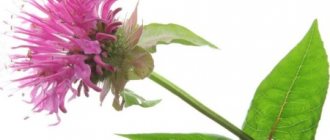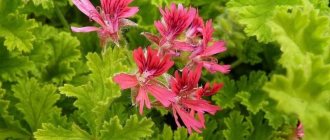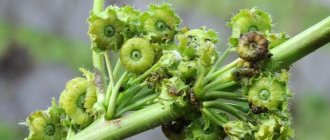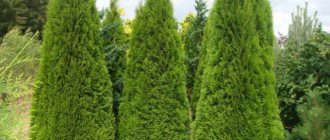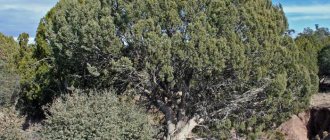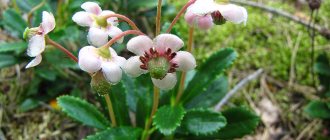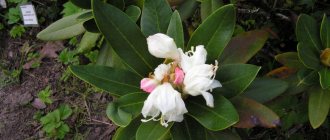Angina flower medicinal properties
Anginnik is a bush with berries that vaguely resemble either cherries or cherry tomatoes. Remains green all year round. It is also called pepper nightshade, which is important not to be confused with the poisonous false nightshade.
The plant received its second name “Cuban cherry” due to the similarity of its leaves to cherry leaves. Places of natural distribution are the humid subtropics of South America. Angina grows up to 80 centimeters. Has a tree trunk. The dense crown consists of dark green foliage.
The flower consists of five petals. The flowers are small, white, self-pollinating, resulting in a bright red round fruit - a berry. Pepper nightshade blooms and bears fruit simultaneously throughout the whole year, which increases its decorative value. The crown can be shaped, shoots shortened, and their ends pinched.
Due to year-round activity, for which an angina sufferer spends a lot of energy and nutrients, regular fertilizer is required, twice a month in warm weather, monthly in cold weather. Otherwise, the indoor plant does not require special care.
The unpretentious sore throat especially decorates winter window sills with its green, red and white bouquet. In summer, when the weather is hot, it needs abundant watering, with soil control, perhaps up to once a day, because a lot of moisture evaporates through the leaves. At the same time, you should remember about good drainage, since the indoor plant begins to hurt from stagnant water. So, you should feel this balance and, without allowing the lump of earth to dry out, gradually and regularly water the plant, observing its reaction. If the leaves begin to turn yellow and fall off, then you need to use less water.
In warm weather, you can take the flower outdoors. In winter, in a cool room, watering is reduced to twice a week. Pepper nightshade propagates very easily either by seeds, which are of the highest quality in early spring, or by cuttings. Planted in prepared soil to a depth of one centimeter. At a temperature of 25ºC, the seeds germinate in two weeks. To transplant into a permanent pot, you need moisture-intensive soil consisting of turf soil, peat, humus and sand, ratio 1:1:1:0.5.
Pepper nightshade grows very quickly and begins to bloom within six months. Replanting must be done for adult plants every two years, while you can increase the pot, and be sure to replace depleted soil with enriched soil.
The healing properties of angina
Pepper nightshade is good for treating throat diseases: The berries are suitable for treating sore throats. Recommended 1 tbsp. l. pour crushed dry berries with 1 glass of boiling water, leave for 2 hours, gargle 3-4, or even 5 times a day.
In addition, the juice of nightshade berries perfectly heals wounds, cuts, and promotes the resorption of boils.
If you want to decorate your home with a charming evergreen and ever-bearing plant, and at the same time receive a healing remedy, find a place for the pretty nightshade in your home garden.
My wife bought pepper nightshade and put it on the windowsill. This tropical beauty decorated our home - at any time of the year, the nightshade branches were simultaneously strewn with white flowers, dark green ovaries, and red beaded berries. Even in the coldest time of the year, when there was snow and icy cold outside the window, the tree stood in the room in all its glory, reminiscent of the sultry summer.
And for a long time we treated nightshade as an ornamental plant. But then in one magazine we read about the medicinal properties of nightshade. It turns out that the plant has another name - “angina”, or “angina tree”. And sometimes it is called “Cuban cherry.” As you understand, one of the names reflects the special ability of nightshade, namely: to cope with throat diseases - in particular, sore throat.
Nightshade berries are suitable for treating sore throat. Recommended 1 tbsp. l. pour crushed dry berries with 1 glass of boiling water, leave for 2 hours, gargle 3-4, or even 5 times a day.
This rinse has more than once helped my wife to quickly relieve inflammation and pain in the throat due to tonsillitis. All our friends who tried to treat their throat in this way were convinced of this.
In addition, the juice of nightshade berries perfectly heals wounds, cuts, and promotes the resorption of boils. If you want to decorate your home with a charming evergreen and ever-bearing plant, and at the same time receive a healing remedy, find a place for the pretty nightshade in your home garden.
Treating tonsillitis at home
Tonsillitis is an acute infectious disease. This is the so-called bacterial tonsillitis, the treatment of which depends on the type of infection and the severity of inflammation of the tonsils. This is an inflammation of the tonsils of any type, and tonsillitis (the more common name for tonsillitis) is especially common in young children. The cause of the disease is microorganisms; viruses. ⇒
Why does a person get a sore throat?
The word sore throat means in English “to tighten, compress.” Indeed, a characteristic symptom of a sore throat is pain that resembles barbed wire tightening the throat. In the human throat there is an effective mechanism designed to protect against various infections - these are the tonsils, colloquially they are called “tonsils”. But sometimes, in the presence of all sorts of unfavorable conditions, this mechanism does not work, so the person gets sick. First. ⇒
How to distinguish scarlet fever from tonsillitis?
One day my child had a sore throat. The doctor diagnosed: acute tonsillitis. Prescribed antibiotics and rinses. But after a while, I noticed that my son’s tongue had turned crimson and his skin had become goose-colored. Even later, when the temperature subsided and the inflammation in the throat passed, suddenly the palms began to go away. ⇒
Evil germs
When examined for microflora (culture from the throat, nose, tongue), my child was diagnosed with: non-hemolytic streptococcus, hemolytic streptococcus, Staphylococcus aureus. Please tell us about these microbes, why they are dangerous and how to get rid of them. I.I. Kubasova Pediatrician Olga Vladimirovna Sorokina explains. - Living microbes. ⇒
nightshade plant
Solanaceae, to which our subject belongs, is a huge family that includes more than 1000 species of crops. These include potatoes, peppers, tomatoes, eggplants, as well as petunia, physalis, etc. In turn, the nightshade flower adopted some external features from its relatives. For example, its white flowers with yellow anthers look a little like potatoes, and its fruits, bright and round, look a little like cherry tomatoes. Although, to some, the red berries resemble cherries, for which the flower received the nickname “Jerusalem cherry.”
Interesting You can often find black nightshade in garden plots. Some people mistake this species for a weed, which is not true at all! After all, its ripe fruits are sweet and edible, suitable for baking, as fillings for pies, as a base for jams and compotes. There are also many ornamental garden species, most of them cultivated as annuals. Only one species is able to survive in harsh winter conditions - bittersweet nightshade, the rest - natives of the southern lands - will not survive the cold.
An interesting feature of the nightshade plant, which makes it attractive to gardeners, is the fact that on one branch there can be fruits that are already ripe and still green. Therefore, during fruiting, and this is a rather long period (from spring to late summer, and in some species until late autumn), indoor nightshade, decorated with balls of different colors, becomes like a New Year tree.
Despite the nickname, the nightshade flower is native to South America, namely from the tropical forests of Brazil, although some species are native to Central America, Southeast Asia, and are found almost all over the world. The second name of the flower is solanum, consonant with the international Latin name Solanum, which literally translates as “no sun.” Why? Perhaps because without enough sunlight, nightshade does not produce colorful fruits. There are a huge number of varieties; only three species have taken root at home.
False nightshade (Solanum pseudocapsicum) is the most common type of house nightshade. This is a shrub with small elongated leaves; it can grow up to 50 cm in height. The peak of decorativeness occurs at the end of autumn, after which the fruits remain on the branches for a long time, and bushes dotted with red balls can be seen on the shelves of flower shops on the eve of the New Year. Maybe that's why it, like poinsettia, is sometimes associated with the Christmas tree.
n. false pepper
Attention! Despite the attractiveness of indoor nightshade berries, you should absolutely not eat them! If they enter the stomach they cause severe poisoning. Therefore, you should not grow it where there are children and pets. Be careful with the leaves of the plant, the juice of which can cause skin irritation.
Pepper nightshade (Solanum capsicastrum) has minor differences from the previous species. The size of the plant itself and its berries is slightly smaller, and on the shoots you can see a fleecy “cover” of a silvery hue. The second name of this nightshade is angina. Unlike false pepper, this species is not poisonous, but is even useful! In folk medicine, an infusion of dried angina fruits is used to treat the throat, hence the nickname. But you shouldn’t practice these activities! After all, due to ignorance, it is quite difficult to distinguish between two similar species, and a mistake will cost your health.
n. pepper-shaped
Another homemade nightshade that has obvious differences is the jasmine nightshade (Solanum jasminoides). Its relative is jasmine. The most decorative of all, it looks more like a vine with elongated leaves and amazingly beautiful flowers collected in white or light blue panicles. The length of the vine can reach one and a half meters even in indoor conditions, so it is often grown as a climbing plant on a support, or as a hanging plant - in hanging flower pots.
n. jasminoides
Based on these species, there are many variegated forms that are distinguished by bright, variegated foliage. The nightshade plant is often grown as an annual if re-fruiting cannot be achieved. But in itself it is quite decorative, and besides, it is not so difficult to make it bloom.
Angina - care:
Anginnik is a light-loving plant, grows well in bright light, and is shaded only during the hottest period of the day in summer.
Temperature:
The preferred temperature for Angina is +18-25°C. In the autumn-winter period, a moderately cool temperature is maintained in the region of +12-15°C; in this condition, Anginnik bears fruit longer.
From mid-spring to early autumn, Anginnik is watered abundantly as the soil dries out. In room conditions, the plant is forced to rest due to lack of light and air humidity, so in October Anginnik is placed in a cool room, where increased air humidity is maintained with limited watering. In February, when a new shoot appears, watering is slightly increased.
Angina is caused by high air humidity. Humidity should be at least 65%. The plant is sprayed daily; it is allowed to place the pot on a tray with pebbles. In this case, you need to make sure that the bottom does not touch the water.
From spring to autumn, Anginnik is fed once every six months with a special liquid fertilizer for flowering houseplants; fertilizer for tomatoes is also used.
An adult Anginnik is transplanted every year at the end of winter, at the beginning of spring. When transplanting to an adult indoor plant, all shoots are cut back to a third of the height.
Reproduction:
Anginnik propagates by seeds and cuttings.
Seeds are sown in spring, placed on the surface of the soil and covered with a thin layer of sand, germinated at a temperature of +20-22°C under polyethylene. Shoots will appear in half a month. After picking twice, Anginnik is planted in a pot and must be pinched. In spring and summer, it can be propagated by cuttings; the cuttings take root well in wet sand or in a mixture of an equal part of peat soil. After the plant has taken root, it must be pinched.
Some features:
To stimulate branching of a young plant throughout the summer, Anginnik is pruned a couple of times.
Rules of care
Nightshade cannot be called a universal plant. It can only be grown if you have some floriculture skills. It is believed that the main components are bright diffused light and moist, cool air. The website flowery-blog.ru will tell you what is important to consider.
Temperature and lighting
Like many plants, indoor nightshade prefers bright, diffused light. During the entire period of flowering and fruiting, the light should be maximum. It can be provided by south-east and south-west windows. Usually, in the presence of lighting, the dormant period is not expressed, so the solyanum can bear fruit for a very long time! If you have purchased a tree with fruits, you should provide it with the brightest place, but preferably not the hottest one. Lamps can help create additional lighting in winter. Artificial light lamps for flowers.
Home nightshade is unpretentious to the temperature regime, so its comfortable range is very wide - from 5 to 35 degrees, the temperature should not fluctuate below or above this limit. It is directly proportional to the lighting: if there is a lot of light, the solyanum grows well and bears fruit at a temperature of 18-25 degrees, and in conditions of limited lighting the temperature must be lowered to 12-16 degrees so that the plant plunges into a state of “sleep”.
Attention! Long-term fruiting can be achieved by ensuring maximum humidity, stable lighting and relative coolness in winter - 16-18 degrees. The budding occurs in February, and flowering usually occurs in the spring. At the same time, in order to have fewer barren flowers, it is advisable to take the tree out onto the balcony or into the garden (only if the temperature is above 10 degrees). In the fresh air, noticeably more fruits are formed! In this case, temperature changes will only harden the flower. Indeed, in Brazil during this period the average night temperature fluctuates in the range of 15 degrees, and the average daytime temperature is about 25.
Watering and humidity
Indoor nightshade is rightfully considered a “water bread”! In the process of caring for him, everything is interconnected. In the summer, when the flower drinks more water, you can water it up to twice a week, generously, but only if the top layer of soil has dried by about 2-3 cm. If the flower is in a cool room where the temperature is below 16 degrees, it is worth watering with great care, when the soil is half dry, trying not to allow moisture to stagnate at the roots. Important watering rules.
The nightshade plant develops well in conditions of high air humidity. Spraying can be done at least several times a day, this will only improve the health of the flower! Sometimes beneficial fertilizers can be added to the spraying water. Foliar feeding: recipes.
Fertilizers and fertilizers
The formation of fruits takes a lot of effort, so the flower simply needs feeding. To support it during the flowering and fruiting period, you can fertilize it once a week, that is, every second watering, adding a little fertilizer - mineral or organic. Nightshade will not mind periodic feeding with organic matter. What is organic matter and how to use it.
When choosing fertilizers for this indoor resident on the eve of spring, you should pay attention to the potassium component, which stimulates flowering. Table of microelements for plants. On the eve of fruiting, solyanum can be fed with fertilizer created for its “relatives” from a number of vegetable crops - tomatoes, peppers, eggplants. This will help in fruit formation. During the rest period, the flower is not fertilized!
Reproduction and transplantation
Although many consider home nightshade to be an annual plant, if you provide it with comfortable conditions and regularly carry out crown formation procedures, it will delight you for many years. In rooms, solyanum grows up to 50 cm in height; pruning can be done on plants 30 cm in height and above. In this case, you can cut off the tips of the branches by 2-5 cm. This procedure is best done at the end of winter at the same time as replanting. Pruning is done by analogy with other indoor trees - Benjamin ficus and hibiscus. Plant the plant in a standard-shaped pot (“tulip” or cylinder), types of flower pots.
Attention! During flowering and fruiting, it is strictly forbidden to replant nightshade!
For the soil, a purchased universal mixture for ornamental foliage plants, or a homemade mixture: from garden soil, compost, peat and sand, is suitable. The nightshade flower loves a moisture-intensive but breathable environment, and will grow poorly in “clogged” clay soil. Soil for flowers: do it yourself. It can be propagated using cuttings left after pruning. They are rooted in water, then transplanted into prepared soil. Nightshade can also be grown from seeds, which are planted in a light mixture of peat and sand. At a temperature of 18-20 degrees and a sufficient level of humidity, sprouts appear within two to three weeks. Seeds planted in March germinate best.
flowery-blog.ru
Cuban cherry (pepper nightshade, solanum, anginnik) is a perennial evergreen plant 60-80 cm high with dark green leaves similar to the leaves of a bay tree and red fruits with a diameter of 1.5-2 cm, very reminiscent of cherries. Its homeland is the humid subtropics of South America, so in other regions it grows in protected soil conditions. At any time of the year, the tree is simultaneously strewn with white flowers, green ovaries, and red fruits. It is especially beautiful against the backdrop of snow cover outside the window, reminiscent of the hot summer.
Reproduction
Nightshade is easily propagated by seeds, which are sown at any time of the year. The seeding depth is 0.5-1cm. At temperatures not lower than 25°C, seedlings appear after 2 weeks. Seedlings dive in the phase of 3-4 leaves into separate pots with a capacity of 0.5 liters. They grow very quickly and bloom in 5-7 months. It also reproduces well by cuttings, which are rooted using conventional technology.
The soil
The plant does not tolerate soil drying out well; therefore, the soil mixture is prepared to be quite moisture-intensive:
- 1 part of turf land,
- 1 part peat
- 1 part humus,
- 0.5 parts sand.
Nightshade does not tolerate stagnant water, so drainage is placed at the bottom of the pot.
Care
In the summer, Cuban cherries are watered daily, and in winter, watering is significantly reduced.
Since fruiting is continuous, the plant needs regular fertilizing with mineral and organic fertilizers. The mixture is suitable for decorative and indoor flowers.
In summer, the plant is taken out into the garden, onto a balcony or loggia, but kept in the shade for the first 2 weeks to avoid burning the leaves.
Nightshade is replanted in the spring in April-May and each time the pot capacity is increased. A young plant is replanted every year, and after 5 years - once every 2-3 years, partially renewing the soil mixture. A two-year-old plant is planted in a 2-liter pot, up to 5 years old – in a 4-5-liter pot, a 7-year-old bush – in a 6-8-liter pot.
To ensure that nightshade has a compact crown with dense foliage, its branches are pruned and pinched. The main shoot is shortened by 1/4 when the plant reaches a height of 25-30cm. Shoots of 2-3 orders are pinched at the top as they grow.
Pests
Cuban cherries are sometimes pestered by aphids. To combat it, the plant is treated with various infusions.
Wood ash infusion: 300g of ash is poured into 1 liter of water and left for 2 days. Then the plant is sprayed. Garlic infusion: 2-3g of chopped garlic are diluted in a glass of water and immediately sprayed on the plant. Tobacco infusion: 10g of tobacco dust is poured into 200g of water and infused for 2 days. Before spraying, dilute with the same amount of water and add a little soap.
The soil in the pot is covered with paper or plastic wrap during processing.
Medicinal properties
Cuban cherries are grown not only as an ornamental plant, but also as a medicinal plant. It treats sore throat, chronic cough, chronic tonsillitis, and prolonged fever of unknown origin. The juice of the berries wonderfully heals wounds and promotes the resorption of boils. Fresh berries (1 tbsp) reduce blood pressure. To treat sore throat, use the following infusion: 1 tbsp. dry berries are poured with a glass of boiling water and left for 2 hours. Gargle 3-4 times a day.
Angina - diseases and pests:
Angina is often affected by greenhouse aphids and whiteflies. The greenish whitefly larva settles at the bottom of the leaf, sucks out the cell sap and leaves a sugary secretion. A faint whitish or yellow spots appear on the leaves. The affected leaf curls, turns yellow and falls off.
Aphids are quite striking at Anginnik, especially if the plant is in the garden. It damages the leaves on the underside and the top of the shoot. The damaged part becomes discolored, the leaf curls, turns yellow and falls off.
In dry air, Anginnik is affected by red spider mites.
Nightshade - Cuban cherry on the windowsill
Nightshade pepper, or Solyanum pseudocapsicum, has been dubbed Cuban cherry due to its fruits, which are indeed very similar to cherry fruits.
Nightshade is a perennial evergreen dwarf tree with a woody stem and dark green elongated oval leaves. Its distinctive feature is its constantly preserved decorativeness: at any time of the year, the branches are strewn with white flowers, dark green ovaries, and bright berries. Caring for this nightshade is not difficult at all. When young shoots begin to grow in March/April, the plants are kept in warmer conditions (preferably a sunny place). In summer, plants are watered and fed generously with fertilizers; closer to autumn, more moderately, until feeding is stopped completely. If plants spend the summer outside, they must be brought indoors in a timely manner, since nightshade is not frost-resistant. The dormant period without drying out the earthen coma lasts from October to February. Before the growing season begins, nightshade is transplanted into good soil for indoor plants. You should not choose a new pot that is much larger than the old one; it is better to carefully shorten the roots of the plant. As sad as it may be, nightshade, regardless of its origin, is most often cultivated as an annual plant. It is one of those “throwaway plants” that are easily parted with once the flowers or fruits have served their purpose. This is unfair, since nightshade blooms and bears fruit again after the winter dormant period. Usually this plant comes into our homes in the form of a relatively low-growing bush. However, with proper care, you can get a standard form about 1 m high from it. At its core, nightshade is an evergreen plant. However, even if the foliage suddenly falls off in winter, after severe pruning, normal young shoots appear in March. Flowers typical of members of the nightshade family, similar to potato flowers and white in color, appear from May to July. Funny round berry-shaped fruits are formed closer to autumn and last longer in a cool room (8-10°C). In such a suitable place for it, nightshade can be kept for about 10 years. I wish everyone good luck in growing flowers.
Thanks for your seeds
Cultures that lived up to expectations
Breed diseases
Helminths in a nursing mother
DIY pyrolysis boiler
PEOPLE'S REPORTER
New from users
Quartet of the most dangerous seedling pests
Seedlings, especially if they grow vigorously, always improve your mood - a new season, and therefore a new harvest.
How to improve purchased soils
Even when using purchased soils, experienced gardeners modify them, adding not only sand, garden soil, etc.
Java radish: not roots, but tops
In our country, radish is the most popular spring vegetable. You won’t surprise us with white, or purple, or even...
Popular
How to improve purchased soils
Even when using purchased soils, experienced gardeners modify them, adding not only sand, garden soil, etc.
How to collect hazelnuts in buckets
Hazelnuts are an amazing long-liver. It can live and bear fruit in one place for up to 300 years. It is no coincidence that it is called
Rooters: select and propagate
The time for cutting cuttings of fruit and ornamental crops is approaching. And to increase the chances of rooted plants, it’s a good idea.
Most popular on the site
Chinchilla is a super profitable animal
Keeping chinchillas today may well become a profitable business for a fairy.
BUSINESS PLAN for breeding chinchillas from Pl.
In modern economic conditions and the market as a whole, it is difficult to start a business.
Why is it useful to sleep without panties?
If you compare people who sleep completely naked under the covers and those...
Lunar sowing calendar for the gardener.
General information:
Angina (Solanum capsicastrum)
– the real name is pepper nightshade. It is popularly known as Anginnik due to the fact that if you have a sore throat, eat two berries a day, and this will speed up recovery. Angina is a relative of the tomato, but the leaves and fruit are similar to cherries. This is a low-growing evergreen plant.
The gray felt shoot is densely covered with elongated, ellipsoidal dark green leaves. The flower is five-petalled, white, self-pollinating. The fruit is in the form of a round, reddish berry, up to one and a half centimeters in diameter.
The homeland of Anginnika is the humid tropic of Anginnika, and here it can be found in the collection of the botanical garden and among lovers of decorative indoor gardening. Anginnik is unpretentious, bears fruit abundantly. It reproduces well by sowing seeds, and at the same time retains the hereditary trait. In just six months, Anginnik will bloom, and soon the fruit will appear, although it is true that it is not numerous.
Angina is especially beautiful when there is a ripe fruit, an ovary, and a white flower on the branches at the same time.
“A snow-white cherry blossomed under the window”
How many works and songs have been dedicated to this fruit. Hello girls. In Rus', cherry is almost a national brand. And over the years, people have learned a lot of useful and not so useful things about this fruit. I’ll try to put together information about the benefits of cherries and their contraindications.
Composition of cherries
Vitamins: retinol (A), C, E (tocopherol), H, P, PP, group B (B1 (thiamine), B2, B5 (pantothenic acid), B9 (folacin)), as well as folic acid.
Organic acids: citric, salicylic, quinic, malic, succinic.
Carbohydrates: natural sugars, such as glucose and fructose, as well as pectin and tannins, and even enzymes.
Microelements: boron, vanadium, iron, iodine, cobalt, manganese, copper, molybdenum, nickel, rubidium, fluorine, chromium, zinc.
Macroelements: potassium, calcium, magnesium, phosphorus.
Natural colors: anthocyanins.
Glycosides: coumarin, amygdalin.
The cherry fruit has a low calorie content - 49 kcal/100 g of ripe berries.
What are the benefits of cherries?
Cherries have many beneficial properties, so let’s “go down” through our body from top to bottom and list the medicinal properties of cherries in that order.
1. It is believed that the substances contained in cherries improve brain activity.
2. Juice from fresh cherry leaves is taken as a healing agent and to stop nosebleeds.
3. A decoction of the leaves is used as an expectorant for flu or sore throat.
4. Cherry fruits are used for coughs and bronchitis, as an antipyretic.
5. Its antiviral and bactericidal properties help with gum inflammation, and also, according to scientists, several cherries (10 pieces) can replace 1 aspirin tablet.
6. Our skin is not ignored: cherry masks have an excellent effect on enlarged pores and oily skin.
7. Nowadays, cherries are given the name “heart berry.” No, this is not because of sincerity, but because of its effect on certain heart diseases. Cherries contain amygdalin glycoside, which weakens strength and reduces the frequency of heart attacks.
8. As I already mentioned, cherries contain coumarin , which is used to prevent the development of cardiovascular diseases (one glass of juice per day), as well as after a heart attack, stroke and other heart diseases. Your family or loved ones with such diseases simply need to include cherries in their diet as a means of preventing complications of arterial atherosclerosis.
9. I think that those who have phlebothrombosis, thrombophlebitis and, in general, have a tendency to thrombosis, will be interested to know that coumarin reduces blood clotting.
10. Due to the high iron content in cherries, it is recommended to eat or drink cherry juice (1 glass of juice per day is enough) for anemia (iron deficiency anemia) to quickly increase hemoglobin levels.
11. Cherry is a unique tree: in folk medicine, not only cherry fruits are used, but also stalks, branches, bark, and, naturally, leaves. Infusions or decoctions are prepared from them and then used as an excellent hemostatic or diuretic.
12. I won’t ignore the joints. If cherry fruits or juice are consumed with milk, arthritis can be cured. Or, for example, cherry pits: such a small thing. But if their kernels are ground into flour, it will also help in the treatment of arthritis. Just remember that the seeds are consumed either fresh or after heat treatment (jam or compote). In other cases, amygdalin breaks down into several substances, including hydrocyanic acid, which is very dangerous and causes poisoning.
13. Decoctions of cherry stalks or emulsions from seeds are recommended for joint diseases (for example, arthrosis), and fresh cherries eliminate inflammation of the joints.
14. A decoction of cherry tree bark alleviates the condition of a patient with radiculitis (relieves pain).
Are you tired yet? Then a little about the gastrointestinal tract and general ailments.
15. If someone has a salt imbalance or has gout, then you can offer milk with fresh cherries, juice or syrup. It is considered a diuretic with a mild effect.
16. Thanks to the bactericidal and anti-inflammatory properties, the stalks of cherries have the ability, quite rare for fruits, to destroy microbes such as streptococci or staphylococci and even act on the dysentery bacillus. To do this, prepare a decoction of the stalks:
Cherry stalks (2 teaspoons) are boiled in 1 glass of water, then left for several hours.
Drink 1 tbsp decoction. spoon 4 times a day.
This decoction, by the way, also has an astringent effect: it helps not only with diarrhea or dysentery, or with uric acid diathesis, but also with long and heavy menstruation.
17. Anthocyanidins reduce the content of uric acid and remove nitrogenous waste from the body.
18. Fiber and pectins are very useful for people with atherosclerosis and obesity, as they remove cholesterol and increase the number of those beneficial bacteria in the intestines that are involved in the synthesis of B vitamins.
Dwarf sand cherry - variety characteristics
In nature, dwarf cherry (lat. Cerasus Pumila) can be found along the banks of mountain rivers. It was first cultivated by the American botanist, author of numerous textbooks, Charles Bessey. He saw excellent decorative properties in this plant. But besides its beautiful appearance, the dwarf sand cherry has other benefits. With proper care, it actively bears fruit.
Ripe berries are dark red, almost black. In diameter, as a rule, they do not exceed 1 cm. I love this plant for its unique decorative properties and the exotic taste of the berries. They are astringent and slightly tart, like bird cherry.
The tree bears fruit regularly and, with proper care, produces a larger harvest every year. By the 6th year of life, the yield can reach 10-12 kilograms per season.
- compact dimensions;
- early fruit ripening;
- easy care;
- wind resistance;
- convenience during harvesting.
Dwarf cherry during the flowering period
The plant blooms in late spring for 2-3 weeks, several flowers in a bunch. Unlike traditional varieties, during flowering the tree emits a pronounced pleasant aroma. Depending on the characteristics of the soil, the flowers may have a white or pink tint. The tree is given additional beauty by neat, bright lanceolate leaves, which turn yellow and red in autumn.
When planting cherries, you should be patient. Seedlings produce color only in the second year of life, and only in the third year does the first fruiting begin.
Botanical description
This biennial plant from the Apiaceae family can grow up to 2 meters in height. Its thick, fleshy and very branched stem is difficult to confuse with other plants. The leaves of angelica are large, dissected into several segments. Throughout the summer, the grass is “preened” with huge white-green umbrella inflorescences, which are very reminiscent of flowering carrots or dill.
Content:
- Botanical description
- What's good about angelica?
- Use in folk and traditional medicine
- Use in cosmetology
- Interesting scientific data
- How to use angelica: daily dosage
- Side effects
- How to prepare correctly
- Use in cooking
Scandinavia is considered the homeland of angelica. For many centuries, this herb served as a source of food and medicine for the inhabitants of northern Finland, Norway, Sweden, and the Inuit who inhabited Greenland. Angelica was extremely popular among the Vikings. From the texts of the Icelandic sagas, we learned that until the early 1000s, this plant was protected by a law that prohibited the total collection of angelica. At one time in Norway, this herb was specially grown in gardens.
Reproduction of dwarf cherry
To propagate dwarf cherries, some gardeners use seeds. I do not recommend this method, it germinates well and produces good shoots, but it can only be used as a rootstock, since the likelihood of preserving varietal characteristics in this case is extremely small.
The best method for propagating the crop is cuttings. I make preparations at the beginning of June. The best time for the procedure is early morning.
When preparing and germinating cuttings, I adhere to the following algorithm of actions:
- I remove the lower leaves on the shoots and make an oblique cut;
- I place the workpiece in water and immediately into a biostimulating preparation containing indolylbutyric acid (Kornevin, Indolyl);
- I prepare pots with a substrate of sand and peat;
- I place cuttings in pots, compact the soil;
- I cover the cuttings with a transparent container and place them in a dark place.
I water the preparations without removing the jars. You can remove the protection after about a month. I replant it to a permanent place in open ground in the spring.
Specifics of caring for dwarf cherries
Dwarf sand cherry tolerates frost well, but before cold weather I carry out a number of standard procedures:
- I remove the dried bark;
- I disinfect wounds with special solutions;
- I burn old branches and leaves.
For the proper development of dwarf cherries, it is important to carry out frequent watering and regular spring feeding.
Caring for dwarf sand cherry and felt cherry is practically the same. You will find detailed information in our article.
The problem with this type of cherry is moniliosis. It appears when the plant fades. If the leaves begin to curl and fall prematurely, I take urgent measures: I cut off the affected areas, separate healthy branches, pulling them back, and tying them up so that the distance from the diseased branch is 10 cm.
Infection of cherries with moniliosis
At the beginning of spring, I treat sick cherries with preparations based on copper and Bordeaux mixture. Fertilizers based on potassium, boron, zinc, and manganese have proven themselves to be excellent preventative agents.
If the disease has spread to most of the tree, it must be dug up by the roots and burned to prevent infection of other plants.
Growing at home
There is a variety of this crop that can be used for growing at home - Cuban dwarf cherry. The plant is planted in a large pot and located in a well-lit place.
The tree can reach a height of 80 centimeters, it blooms and bears fruit all year round. Every spring, the cherry tree should be replanted, choosing a new pot that matches the size of the grown tree. Otherwise, caring for a house plant is no different from a garden one.
Growing Dwarf Cuban Cherries in Pots
The dwarf sand cherry is a beautiful ornamental tree that produces healthy and tasty berries with proper care. Knowing the simple rules, every gardener will be able to grow this plant in his own area.
Growing angelica in the garden
Sowing
For growing angelica, well-lit areas or those in partial shade are best suited, and the soil should be nutritious, well-moistened and permeable. The site is prepared immediately before sowing; for this purpose, it is dug up and humus or compost is added to the soil. Then the surface of the area is leveled. This crop is sown in open ground in September before winter; before the onset of spring, the seed will have time to undergo natural stratification. Seeds need to be sown thickly, because their germination rate is relatively low. If excessively dense shoots appear in the spring, they will need to be planted, adhering to the 60x40 or 60x30 centimeters pattern. Crops do not need shelter for the winter.
In the case when the sowing of angelica seeds is planned for the spring, they will need to be stratified. To do this, the seed is placed in the refrigerator on the vegetable shelf, where it will remain for 3 winter months. However, do not forget to first combine it with moistened sand and pour the resulting mixture into a container. Most often, with the onset of spring, very few germinating seeds remain.
Angelica care
After the seedlings appear, it is recommended to mulch the surface of the bed with moss, which will have a beneficial effect on plant productivity. It is very simple to grow angelica on your own plot; to do this, you need to water it during drought, remove weeds from the plot, feed it with mineral fertilizers twice a season, often loosen the soil surface around the bushes, and also, if necessary, protect them from harmful insects and diseases.
Diseases and pests
In some cases, such a herbaceous plant is affected by fungal diseases, namely powdery mildew or rust. Experts do not recommend spraying bushes with chemicals, as they are characterized by their ability to accumulate toxic substances. In this regard, it is better to resort to preventive measures: adhere to the rules of crop rotation, feed the plants with mineral fertilizers with a minimum amount of nitrogen, and systematically remove weeds from the garden beds.
Angelica is distinguished by its resistance to drought, and the greatest danger of harmful insects for it is the spider mite, which also prefers dry weather. In order to get rid of ticks, the bushes should be sprayed with tobacco infusion. To prepare it, combine three liters of water and 0.2 kg of tobacco or shag; after a day, the infusion will be ready. The strained infusion must be combined with 50 mg of liquid soap to increase its stickiness, then the bushes and the soil underneath them are treated with it.
